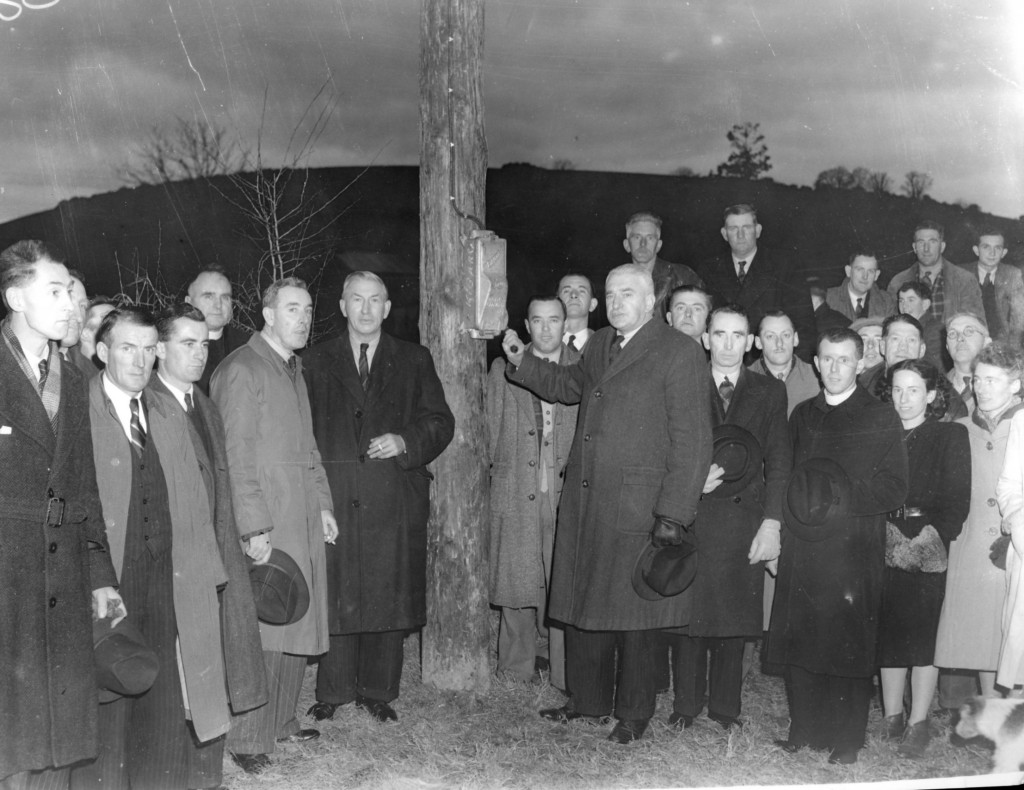
Kieran’s Our City, Our Town article, Cork Independent, 22 April 2010
In the Footsteps of St. Finbarre (Part 209)
The Quiet Revolution
In the Ireland of the 1940s and 1950s, Irish people saw widespread electrification and mechanisation of their way of life. The physical and cultural fabric of Ballincollig also experienced vast change. In particular, on Tuesday 20th and Wednesday 21st January 1948, the Hurler’s Hall in Ballincollig became the ESB’s base for demonstrating the benefits of electricity to the general public in rural areas not yet possessing the technology.
Approximately 300 people turned up to the Wednesday evening as revealed through archived field notes by P.J. Ennis of the Development Division. His notes can now be read in the ESB Archive in Dublin. P.J. Ennis talks of Ballincollig as close to Cork City and having electricity for quite a while and hence was a central hub for attracting people from the surrounding region to hear the ESB’s sales pitch. He noted that a Mr Lyons made a thorough sales canvass immediately after the display and harnessed the ‘new’ hire purchase agreements as a means of inducing very small famers to buy into the kettle and iron sales.
Between 1923 and 1929 an Electricity Supply Bill was proposed in order to establish Ireland’s Electricity Supply Board. The state board was founded on 11 August 1927, focusing on the countrywide distribution of electricity and the promotion of its use. The marketing for the electricity campaign proved successful and in the ten years from 1932 to 1942 the number of the Board’s customers jumped from 77,134 to 200,000. The initial stages of electrification were confined to large towns and large villages. In 1932 the demand for electricity was approaching capacity and the Board had to look again at the River Liffey hydro electric scheme project. The war years was a tough period in the history of the ESB as the Board struggled to provide supplies for its customers.
Developments were not confined to increasing generation capacity and a major step was taken on the distribution side of the business when in August 1943, the then Irish government announced its approval of the ESB scheme for rural electrification. In Michael J. Shiel’s book (2003) The Quiet Revolution: The Electrification of Rural Ireland, 1946-1976, he outlines the ESB’s strategies for a successful rollout.
William F. Roe (1904-1982) was the electrical engineer who led the rural electrification scheme in Ireland. A Kilkenny man William Roe’s early career in the ESB saw him as District Engineer in Portlaoise, Waterford and Cork City. When the Rural Electrification Scheme was initiated in 1945, William Roe was based at the ESB station on Albert Road in Cork. In 1950, he was appointed Assistant Chief Engineer of the ESB and in 1965 Deputy Chief Engineer, all the time keeping his finger on the pulse of the Rural Scheme.
Despite many post-war difficulties, the scheme got under way in 1946 and the first pole was erected at Kilsallaghan, County Dublin on 5 November 1946. By the following year an area for development had been established in twenty-three of the twenty-six counties. In 1948, seven of the areas had been completed. Area officers of the Board were urged to have a word with the parish priest or work through such organizations as Muintir na Tíre, Young Farmers’ Clubs or the ICA. There were always some people in every parish who were anxious to procure electricity for their area. Inniscarra was the first rural electrification scheme to be put in operation in County Cork. The Cork Examiner on 23 December 1947 reported:
“By throwing a switch at Curaheen a few miles from Ballincollig yesterday afternoon, Mr Henry Golden, Cork, ESB, brought light to 100 houses in the Inniscarra area. When Mr Golden operated the switch, which was on a pole, a lamp on the pole was lighted and bulbs in nearby houses glowed in the gathering darkness. Thirty-two more houses will receive their electric current supply soon after Christmas, and by March 750 houses which have contracted to take supply in this area will have the benefits of electricity”.
An account is given by two ESB officials in Aghabullogue, Con O’Shea and his assistant Jerry Linehan. The two of them, working together and marketing electricity visited every house. They answered any questions asked by the local community. Prior to doing the survey they were advised never to visit too early in the morning and never to refuse a cup of tea. They cycled all over the parish and completed the survey in three months. The organizing committee was overjoyed when it was announced that their application was successful and eventually the power was switched on in September 1949.
Even though electricity was now available, people were still very slow in making full use of the facility. The rural electrification scheme made steady progress and by 1959 75 per cent of the country was completed. However, it was not until 1975 that the last area, the Black valley in County Kerry, was electrified. By that time, more than 370,000 rural dwellers had been supplied. The benefits to people of rural Ireland were widespread and revolutionary. Indeed, the programme has been called The Quiet Revolution.
To be continued…
Captions:
536a. Switch on at Inniscarra, 22 December 1947 (pictures: ESB Archives)
536b. picture of ‘gang’ of rollout of rural electrification scheme
